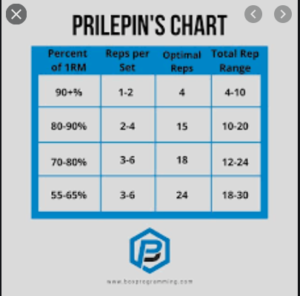Blog 32 – SCIENCE!
A member asked me the other day, “How do you workout, Dylan?” (… but it sounded an awful lot like, “Do you even lift, bro?”) I gave a long-winded answer – per usual – about using COVID to play around with and test a 12-week program based on the conjugate method; a method made popular by at Westside Barbell in Columbus, OH (for those of you who have heard of them… No, I am not on nor do I support the use of steroids.). It’s not really as fancy as it sounds. Foundationally, it isn’t that much different than any other strength program by breaking up movement patterns and intensities over the course of the week. The main components that define the conjugate method though are:
- 2 maximum effort days and 2 dynamic effort days/week
- A focus on lift variations (ex. squat = box squat or deadlift = rack pull, etc.)
- A focus on accessory work
It’s one of the first sport specific methods that prioritized general physical preparedness, or GPP as it’s popularly called these days (machines like the reverse hyper and the belt squat, light sled drags/pulls for distance or time, and the use of bands/chains for accommodating resistance were popularized by Westside Barbell). Anyway, I’m probably missing something, but that’s the basics. What’s really important here is why I chose to utilize this method rather than, say, a methodology like CrossFit, Easy Strength, Starting Strength, the Coan Method, Wendler, the Bulgarian Method, etc. The bottom line being, I like steroids. ( that’s a joke) In reality, the method prioritizes the use of variation and accessory, which ultimately decreases the range of motion and use compound/multiple joint exercises (reducing wear and tear), while at the same time increasing loading capacity and the ability to more specifically target weaker parts of the body (producing GAINZ). All things that benefit a person with a fused spine, arthritis, decreased muscle structure/function, and a locked ankle.
But the point of this blog isn’t to get lost in my affinity for the conjugate method (as Dr. Paul likes to state, “Methods are many, principles are few.” A lot of people have gotten REALLY strong, fit, buff, toned, HUGE!, whatever doing a lot of different things.) The point of those blog is to give you a better idea of why we chose to give you a certain number of reps at a certain percentage or loading variation, and better empower you to choose your own loading during our Group Strength and Conditioning or Strength Tribe classes. Enter Prilepin’s Chart, or as I stated in the title, “SCIENCE!” (Caveat to all my scientist readers… this chart was developed through the observation of high level training athletes in Russia – I know more steroids. – and NOT through a quantative scientific method. We’ll call it qualitative science so you don’t troll me in the comments… or maybe just “Bro” science.) Prilepin’s Chart looks like this:
Chart screenshot taken from Conjugate Strength and Conditioning by Jason Brown, MS, CSCS of BP Training Systems.

Its basic claim is that any weight relative to a person’s maximal capacity can be utilized as a ticket to board the GAINZ Train. The Chart goes one step farther than a traditional percentage/rep max calculator chart by also prescribing an optimal rep range. (There’s also an intensity/intent component to the chart that is not included for the sake of simplicity here… Did someone just say foreshadowing?) Now certainly, the chart is not perfect. There are many anomalies or circumstances that work outside of the chart. For example, my central nervous system does not work well enough for me to lift above 90% for 4-10 reps, so I spend a bulk of my strength work between 80 and 90 (something a program like Easy Strength promotes). But, and keeping our sciency theme, almost all of us will fit within 1 standard deviation from the mean of this chart. In bro terms, the vast majority of this chart applies to the vast majority of people. And in reality, you’ve already experienced this at play in class.
Every strength session (5×5 @ 75%, 7×1 @ 92%+, EMOM 10 2 Snatches @ 65%, etc.) that we do has bits and pieces of this loading framework, but it also appears in our WOD training sessions, like when we do ‘30 Clean and Jerks For Time’ you’re probably working at a weight that is around 50-60% of your loading capacity. OR if you were to take a ‘21-15-9’ we’re looking at 45 total reps, which this chart would say we’re working at about 40% of total capacity. There are certainly limits on this as well, like the consideration that many of us don’t have a true/tested 1RM, which would make the loading prescription calculation lower than “optimal.” We may have never thought about our workouts this way, but again “methods are many, principles are few.” *reader squints eyes and nods head in intellectual approval*
So as we look at workouts moving forward, whether in GSC or Strength Tribe or even Bootcamp, know that regardless of the work out that is written you have the ability to change the weight and reps (up AND down) to fit more optimally to your body and goals. And when all else fails… STER… NO! Ask your coach.
D